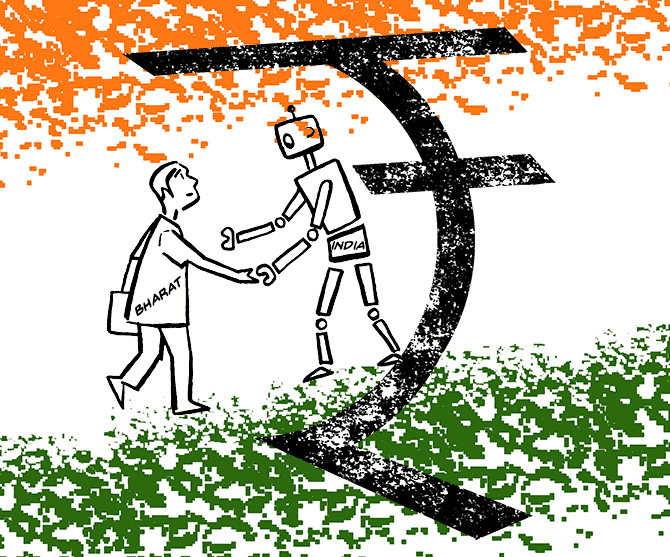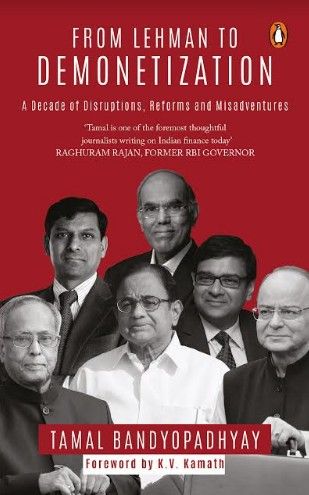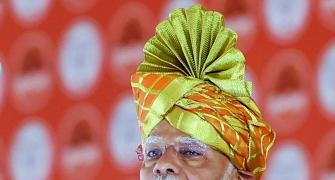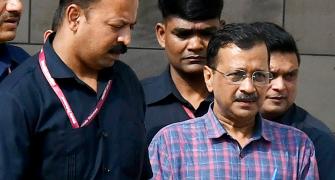Most adult Indians should have access to bank deposits, credit and remittance facilities as well as insurance and mutual fund products in the next decade, and technology will play a big role in this transformation, says Tamal Bandyopadhyay.
Illustration: Dominic Xavier/Rediff.com.

Through the essays in the book, I have tried to chronicle the developments in Indian banking and finance over a tumultuous decade. And, through this epilogue, let me attempt to play the role of a soothsayer, peer into the crystal ball and foretell Indian banking 2025.
What we have been witnessing in the past few years is, to use a cliché, a conundrum. Banks in India, particularly most State-owned banks, have been piling up bad assets and the health of some of them is in such a state that both the government and the Reserve Bank of India have been pushing for consolidation in the industry. At the same time, the RBI is also opening up the sector for new entities.
Consider the fact that since Independence till July 2015, in 68 years, India got 12 new banks (all of them have not survived).
On the other hand, since August 2015, we have got two new universal banks, 10 small-finance banks (at the time of writing this, eight of them are operational) and 11 payments banks (not all are operational as yet even as a few have surrendered their licences).
What more, the RBI has put the licence for universal banking on tap. This means, there is no special window for seeking a new bank licence. Any entity can knock at the regulator’s door any time and walk away with a licence to set up a bank if it is ‘fit and proper’.
The RBI is also planning to open the turf for new kinds of banks such as wholesale banks and depository banks. Besides, the foreign banks operating in India are being encouraged for local incorporation (one of them has already got the nod for its Indian subsidiary) and it won’t be a surprise if the large cooperative banks are asked to migrate into full-fledged commercial banking over the next few years.
There is an apparent contradiction in the trend but consolidation (in the public-sector banking industry) and expansion (in overall) are probably both sides of the same coin.
The banking regulator wants to intensify competition by opening up the sector and forcing some of the public-sector banks to merge and consolidate. While the blueprint for this is being drafted, it is for sure that the public-sector banks, which currently account for around 70 per cent of the industry, will lose their market share probably to 60 per cent by 2025.
Similarly, the credit offtake in past few years has been tardy. For fear of creating more bad assets, many banks are afraid of giving new loans. That has led to the resurgence of the non-banking finance companies. Both their balance sheet growth and the rise in the value of their shares in the stock market in the past few years have been phenomenal. Does this mean the next decade will belong to the NBFCs? Will India cease to host a bank-led financial system by 2025? This is something we need to watch out for.
Till the NBFCs complete one full cycle -- say, of eight to 10 years -- it will be difficult to declare all of them winners. They are subject to light-touch regulations and it’s not easy to predict which entity will end up showing big holes in their balance sheets in the future. Only when the tide goes out, we will discover who have been swimming naked.
Talking about NBFCs, the flavour of the next few years will be financing affordable housing. The government is betting big on this. Its mission is ‘Housing for All by 2022’ and it is backing this up with fiscal incentives. A burgeoning housing sector fuels economic growth as it has a multiplier effect in terms of sale of cement, steel and other housing material, and can create jobs, and lead to increased investment in education.
There are about 20 new entrants in the affordable housing space even as the 14 existing lenders are significantly expanding their portfolios of low-cost home loans by broadening their distribution channels through direct sales and community-based loans. They are all using technology to reach out to the lower end of the customer segment. There has also been a rate war to woo the customers. A burgeoning middle class, rising disposable incomes and fiscal incentives on home loans have increased the affordability of homes, and the average age of a new home buyer in India is now 32 years, down from early 40s a decade ago.
Even though the little over Rs 12-trillion Indian mortgage market has been growing at around 18-19 per cent every year, its size is too small in relation to the economy -- around 9 per cent of the GDP, less than half of what it is in China. Singapore’s mortgage market is 32 per cent of its GDP, lower than Hong Kong’s 41 per cent, and in the US and the UK, it is 81 per cent and 88 per cent of the GDP, respectively. In Denmark, the southernmost and smallest of the Nordic countries, the mortgage market is 104 per cent of the GDP.
Most bankers are seeing enormous opportunities in the market with a shortage of close to 19 million units in urban India and around 40 million in the rural pockets. One hopes that no one is losing sight of the affordability of the customers in this segment, compromising on loan appraisal and risk management, and that bubbles are not seen after a few years.
One set of NBFCs will definitely find it difficult to maintain the growth -- the microfinance institutions. A few years down the line, I will not be surprised if I hear the experts shouting, ‘Microfinance is dead; long live microfinance!’ The market of microloans will continue to grow, but the process of intermediation will change.
The proposed merger of Bharat Financial Inclusion Ltd with IndusInd Bank Ltd signals two new trends: one, the high-margin business of the MFIs is under threat by the new set of small-finance banks as well as some of the existing commercial banks which are seriously planning to penetrate semi-urban India; and two, at the right prices, the banks will be willing to buy the good MFI franchises to expand in the hinterland.
For the MFIs, the pitch has been queered for multiple reasons.
For instance, for a large MFI, the spread or the difference between the cost of funds and the price of its loan is capped at 10 percentage points. This means that if such an MFI is raising loans from other banks at, say, 10 per cent, it cannot charge more than 20 per cent for its loans. The banks which have access to lower-cost funds in the form of deposits do not have any such cap; they can charge their borrowers as much as they want. For the small borrowers, access to bank loan is more critical than the cost of the loan.
Also, a small borrower cannot take money from more than two MFIs, but the banks are not subjected to any such restriction.
Most importantly, cash has been the medium of transaction in the segment where the MFIs operate. The increasing focus on digitisation is hurting their business. To survive and flourish, the MFIs will have to forge alliances with different kinds of banks -- small-finance, payments and universal banks -- as well as digital wallet service providers, and disburse and collect money through the banking channel.
Theoretically, this new architecture will make money expensive for the small borrowers as the money cannot be disbursed at their doorsteps any more. They would need to travel to the nearest bank branch or the banking correspondent, and in the process, they may lose half a day’s wage and/or incur costs in transport.
On the other hand, the operational cost for the MFIs will come down as they would not need so many people for the disbursements of loans and collection of repayments. This will help them bring down the price of loans and compensate for the additional cost that the borrowers will incur.
However, this is a theory.
In reality, the MFIs will find the going tough. The universe of small loans is big but the banks and other NBFCs will gradually replace the MFIs on this turf. A few successful small banks will become universal banks by 2015 while others forge alliances with banks; a few more strong MFIs will migrate to the path of small-finance banks and many MFIs will be taken over by the banks.
 All these will give a big leg up to the financial inclusion drive. Till mid-September, at least 302.5 million accounts have been opened in the Pradhan Mantri Jan-Dhan Yojana scheme, the most ambitious financial inclusion drive globally, launched in August 2014. The money kept in these accounts is only Rs 666 billion, and many such accounts do not have any money kept or they are zero-balance accounts, but the fact remains that they have served a critical purpose -- access to banking for the people at the bottom of the pyramid, the first step towards financial inclusion.
All these will give a big leg up to the financial inclusion drive. Till mid-September, at least 302.5 million accounts have been opened in the Pradhan Mantri Jan-Dhan Yojana scheme, the most ambitious financial inclusion drive globally, launched in August 2014. The money kept in these accounts is only Rs 666 billion, and many such accounts do not have any money kept or they are zero-balance accounts, but the fact remains that they have served a critical purpose -- access to banking for the people at the bottom of the pyramid, the first step towards financial inclusion.
We all know that it will take a while to achieve financial inclusion in the truest sense of the term -- access to credit at a reasonable price without much hassles. We also know that social and economic inclusion must precede financial inclusion. But let’s admit that the PMJDY, to start with, is giving a big push for inclusive finance by opening millions of bank accounts and routing subsidies through these accounts. By 2025, most adult Indians should have access to bank deposits, credit and remittance facilities as well as insurance and mutual fund products.
Finally, technology will play a big role in this transformation.
Ideally, this book should have a chapter on technology in banking, but I didn’t dare to attempt that as it has been difficult to keep pace with the changes in this space. I thought anything I write on banking technology would be irrelevant by the time the book gets published.
In 2015, in the run-up to its launch, IDFC Bank Ltd, India’s newest universal bank, was desperately looking for a unique selling proposition, or USP. How could it become different from other banks of its ilk in Mumbai where it is headquartered? It decided to showcase the ease of transactions as its USP or the differentiating factor from other banks. However, even before IDFC Bank was formally launched in October 2015, other banks such as HDFC Bank Ltd, ICICI Bank Ltd, Kotak Bank Ltd, Axis Bank Ltd and the State Bank of India took giant strides on the technology front, creating mobile wallets, offering their customers ease of transaction and cutting down the time for sanctioning loans.
Use of Big Data, artificial intelligence, and even robots are the in-thing in Indian banks now; many private banks are showing the door to thousands of employees who are not needed in the new landscape. By 2025, or even before that, the point of sales, or PoS, machines and even ATMs and credit cards can become obsolete as the smartphone will be the main mode of all banking transactions.
And, to meet the young, impatient customers’ increasing demand for prompt and smart services, the banks will have to operate like air-traffic controllers, working 24X7. By 2025, at least a few banks will consider themselves as technology companies and feel tempted to say, ‘We also do banking.’
Will that be the slogan of 2025? Many believe that we don’t have to wait for that long; it can even happen by 2020.
I have a different take on this. In India, it can happen, but in `Bharat’, the banks will have to continue to treat technology as an enabler; technology by itself cannot be a product, at least in the foreseeable future. For various reasons -- ranging from connectivity to lifestyle and the pattern of cash flow of individuals and small businesses -- ‘Bharat’ will continue to depend on relationship banking for small borrowers, and technology will cement that.
The challenge before us is to merge India and ‘Bharat’ on the banking turf.
Yes, only technology can achieve that, but it is too ambitious to expect that to happen by 2025.
Excerpted from From Lehman to Demonetisation, A Decade of Disruptions, Reforms and Misadventures, by Tamal Banbyopadhyay, published by Penguin India.







